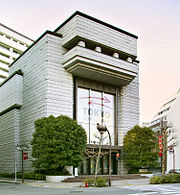The TSE is incorporated as a kabushiki kaisha with nine directors, four auditors and eight executive officers. Its headquarters are located at 2-1 Nihombashi Kabutocho, Chūō, Tokyo, Japan. Its operating hours are from 9:00 to 11:00 am, and from 12:30 to 3:00 pm. From April 24, 2006, the afternoon trading session started at its usual time of 12:30 p.m.
Stocks listed on the TSE are separated into the First Section (for large companies), the Second Section (for mid-sized companies), and the "Mothers" section (for high-growth startup companies). As of March 2006, there are 1,721 First Section companies, 489 Second Section companies and 156 Mothers companies.
The main indixes tracking the TSE are the Nikkei 225 index of companies selected by the Nihon Keizai Shimbun (Japan's largest business newspaper), the TOPIX index based on the share prices of First Section companies, and the J30 index of large industrial companies maintained by Japan's major broadsheet newspapers.
89 domestic and 19 foreign securities companies participate in TSE trading. See: Members of the Tokyo Stock Exchange
Other TSE-related institutions include:
- The exchange's press club, called the Kabuto Club (兜倶楽部 Kabuto kurabu), which meets on the third floor of the TSE building. Most Kabuto Club members are affiliated with the Nihon Keizai Shimbun,Kyodo News, Jiji Press, or business television broadcasters such as Bloomberg LP and CNBC. The Kabuto Club is generally busiest during April and May, when public companies release their annual accounts.
On 15 June 2007, the TSE paid $303 million to acquire a 4.99% stake in Singapore Exchange Ltd.
Prewar history
The Tokyo Stock Exchange was established on May 15, 1878, as the Tokyo Kabushiki Torihikijo (東京株式取引所) under the direction of then-Finance Minister Okuma Shigenobu and capitalist advocate Shibusawa Eiichi. Trading began on June 1, 1878.
In 1943, the exchange was combined with ten other stock exchanges in major Japanese cities to form a single Japanese Stock Exchange (日本証券取引所 Nippon Shōken Torihikisho). The combined exchange was shut down and reorganized shortly after the bombing of Nagasaki.
Postwar history
The Tokyo Stock Exchange reopened under its current Japanese name on May 16, 1949, pursuant to the new Securities Exchange Act.
The TSE runup from 1983 to 1990 was unprecedented, in 1990 it accounted for over 60% of the world's stock market capitalization (by far the world's largest) before falling precipitously in value and rankings today, but still remains one of the 3 largest exchanges in the world by market capitalization of listed shares.
The trading floor of the TSE was closed on April 30, 1999, and the exchange switched to electronic trading for all transactions. A new facility, called TSE Arrows (東証アローズ Tōshō Arrows), opened on May 9, 2000.
In 2001, the TSE restructured itself as a stock company: before this time, it was structured as an incorporated association (社団法人 shadan hōjin) with its members as shareholders.
I.T. issues
The exchange was only able to operate for 90 minutes on November 1, 2005, due to bugs with a newly installed transactions system, developed byFujitsu, which was supposed to help cope with higher trading volumes. The interruption in trading was the worst in the history of the exchange. [2]Trading was suspended for four-and-a-half hours.
During the initial public offering of J-Com on December 8, 2005, an employee at Mizuho Securities Co., Ltd. mistakenly typed an order to sell 610,000 shares at 1 yen, instead of an order to sell 1 share at 610,000 yen. Mizuho failed to catch the error; the Tokyo Stock Exchange initially blocked attempts to cancel the order, resulting in a net loss of 347 million US dollars to be shared between the exchange and Mizuho. Both companies are now trying to deal with their troubles: lack of error checking, lack of safeguards, lack of reliability, lack of transparency, lack of testing, loss of confidence, and loss of profits. On 11 December, the TSE acknowledged that its system was at fault in the Mizuho trade. On 21 December, Takuo Tsurushima, chief executive of the TSE, and two other senior executives resigned over the Mizuho affair. [3] [4] [5] [6] [7] [8] [9] [10]
| Wikinews has related news:Heavy selling leads to shortened session at Tokyo stock exchange |
On January 17, 2006, the Nikkei 225 fell 2.8%, its fastest drop in nine months, as investors sold stocks across the board in the wake of a raid by prosecutors on internet company livedoor. The Tokyo Stock Exchange closed early on January 18 due to the trade volume threatening to exceed the exchange's computer system's capacity of 4.5 million trades per day. This was called the "livedoor shock." The exchange quickly increased its order capacity to five million trades a day.



No comments:
Post a Comment